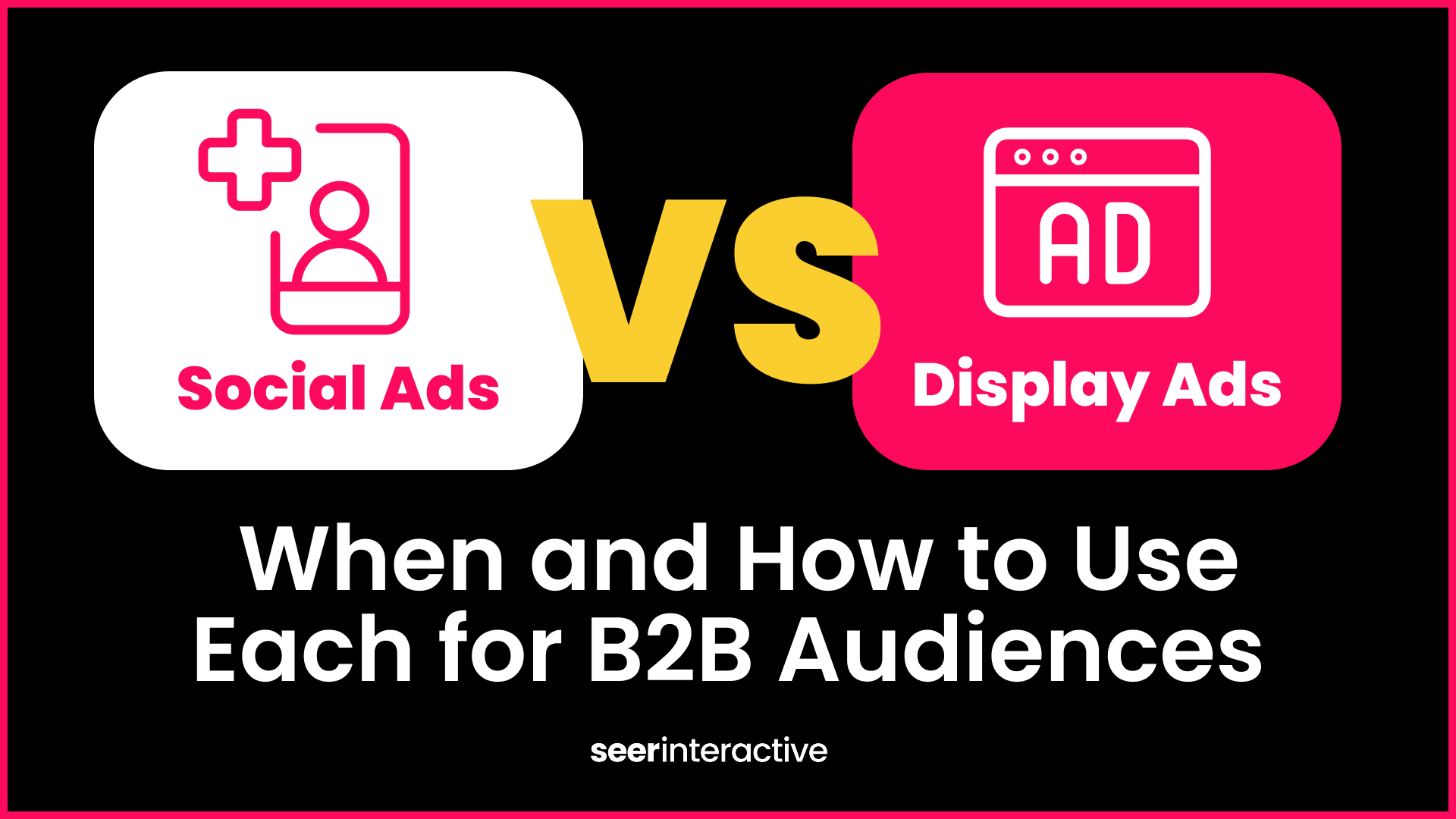Flirting with the idea of implementing Google's Responsive Search Ads? Look no further. Here’s the guide you need to push you in the right direction.
In this blog, we'll cover:
- What are RSAs?
- How to Add RSAs to Your Account
- Best Practices
- How to Measure the Impact of RSAs
- Getting the Most Out of Your RSAs
Have you ever wondered what ad copy resonates best with your target audience?
“Yes!” you exclaim. “Every single day.”
Have you ever spent hours crafting ad copy to align perfectly with your landing pages to improve quality score?
“Of course!” You quip, “I am a paid-media marketer after all!”
...But then spend even more hours setting up never-ending A/B tests to determine if “Learn More” drives more value than “Get Info”?
“Well, yes, but…I still don’t know how “Request a Demo” stacks up…” you ponder as you sip your 3rd morning coffee.
And then when you go to measure performance, you get stuck on whether or not click-through-rate (CTR) or conversion-rate (CVR) should be the success metric (KPI)?
“Version A gets a higher CTR but version B drives a more efficient CVR. Hmmm. But then version C seems to be getting a better cost-per-lead (CPL)? I guess I will pick one and roll with it?”
And so it has been since the dawn of time.
But all-of-a-sudden, a bright light shines down upon your face and a voice thunders from the clouds, “hark, you do not have to live in squalor any longer. I, the almighty Google, do hereby bestow upon you the gift of Responsive Search Ads!”
“Wow!” you think to yourself. “I wonder what Responsive Search Ads are? Where do I even start?!”
“Fear not!”, the voice of Google booms, “this blog post will give you the tools to change your ways and join the paid search automation movement.”
What are RSAs?
"'Responsive search ads let you create an ad that adapts to show more text—and more relevant messages—to your customers.' - Google” - Michael Scott
Responsive Search Ads (RSAs) allow you to enter multiple headlines and descriptions that Google will automatically test through their machine-learning algorithm to show your customers the ad combination that is most relevant to their needs and most likely to improve performance (i.e. no more building endless ad combinations and setting up tedious experiments.)
The RSA ad type allows for up to 15 headlines and 4 descriptions. Google takes that copy and combines thousands of potential variations into an Expanded Text Ad (ETA) format to be displayed in search results (up to 3 headlines and 2 descriptions) that is tailored to each user’s search.
With Google’s expansion of close match variants last year, automated ad copy like RSAs has become a vital avenue for reaching customers with relevant messaging as your ads are more likely to show for broader search queries.
Benefits include:
- Time saved from ad copy set up and testing to devote to account strategy.
- Google tests thousands of ad variations and serves customers ads that are most relevant to their needs.
- Ads are more flexible and adapt to device widths.
- Ads reach more customers as ad combinations allow you to match to more search queries.
- More clicks and potentially conversions because you are competing in more auctions.
The end goal of RSAs is to match customer intent while also expanding your campaign reach to improve performance.
How to add RSAs to your account
RSA’s are easy to add to your account. Follow these simple steps to get up and running:
Log into your account and click “Ads and Extensions” > “Ads”
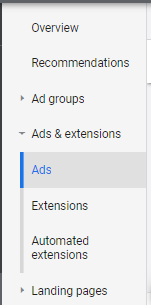
Click the blue “+” and select “Responsive Search Ads”
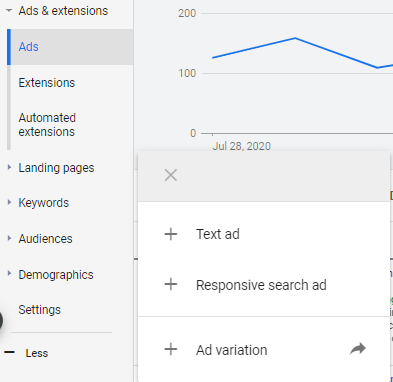
Select the campaign and ad group where you want to add the RSA and input your ad copy elements (headlines, descriptions, final URL, and paths)
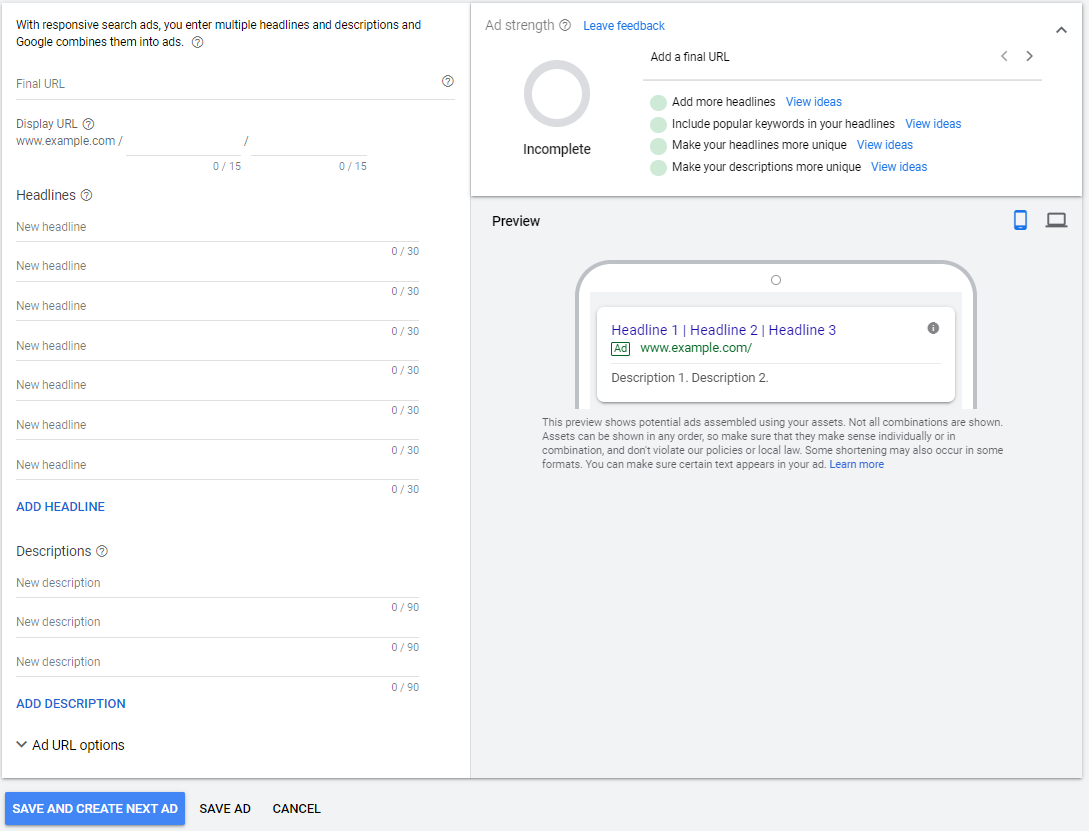
Click “Save” and you’re done! Congrats on being so cool.
If you’d like to add multiple RSAs, rather than upload each ad individually in the user-interface (UI), we recommend building a bulk upload sheet in Excel and uploading via Google Ads Editor.
Best Practices
“Alright, alright, alright” - Matthew McConaughey. Now that you know how to upload RSAs into your account, let’s talk about best practices and how to get the most out of your ads.
- Utilize at least 2 ETAs and 1 RSA in every ad group. Taking advantage of both ad types allows you to benchmark performance and understand what works for your campaigns.
- Don’t know where to start with RSA copy? Start simple and use top-performing Expanded Text Ad (ETA) assets in your RSAs.
- Take advantage of all headline positions (15) [Min rec’d: 10] and description positions (4). Give Google more opportunities to match your ad copy to customer intent.
- Make headlines unique. Repetitive copy will reduce Google’s ability to mix-and-match which will reduce the overall benefits of this ad type! (ie. don’t repeat the same words or phrases in every headline).
- Include keywords in headlines. It’s all about relevance. Using keywords in your ad copy helps to tie the customer experience together from their initial search to ad to landing page.
- Only “pin” if absolutely necessary. Google allows you to “pin” a headline or description in place. For example, if you want your brand name to always be in headline 1, you can “pin” it to that position.
- Similar to making headlines unique, pinning reduces Google’s ability to truly automate the ad testing. Only pin if your company or client has legal or editorial requirements.
Leverage “Ad Strength” to help you get the most out of RSAs.

According to Google, RSAs can drive up to a 10% increase in clicks or conversions.
How to Measure Success
At this point, you understand what RSAs are, how to implement them, and how to set yourself up for success by following “best” practices. Now, let’s dive into the trickiest aspect of RSAs, and ad copy in general...measurement.
The biggest “issue” that we hear when discussing RSAs is that you can’t see the performance of each individual ad variation. Although Google shows you the ad variations with the most impressions, the only way to truly understand RSA performance is to look at the roll up metrics at the overall ad level. At this level you can see all of the expected data like impressions, clicks, conversions, cost, and more.
Some people may insist that this is a drawback, but I am here to tell you that it is not a drawback and those people are wrong. At Seer, we use a “stop, start, keep” framework to help inform decision making. With that in mind, I am going to say some things that you might disagree with entirely, but trust me, they’re the truth.
STOP:
Determining success of ad copy through metrics like impressions, clicks, CTR, or even CVR! Unless your business goal is truly brand awareness, these metrics tell you, your client, or your boss absolutely nothing about how your ad copy tests improved the bottom line...or even the top line for that matter.
Imagine walking into your CEO’s office and telling them that you improved CTR 25% with RSAs. They would look at you like you have three heads! What does that tell them? Nothing. As digital marketers, we can easily get stuck in our own siloed channel metrics, but it is vital to take a step back and understand what is truly valuable.
START:
Defining success for your ad copy testing and performance by what drives business value. Metrics like revenue, leads, return-on-ad-spend (ROAS), or CPL tell you how impactful your efforts truly are.
Imagine that same scenario, but this time you walk into your CEO’s office and tell them that you increased revenue 25% with RSAs. I expect you would receive a completely different reaction.
KEEP:
Testing and optimizing ad copy to maximize the benefits of automation. It doesn’t stop after you add one RSA to your ad groups. Start rotating in new variations and striving for constant, iterated improvement.
Measuring Incrementality
Now that you know what to measure, let’s talk about the incrementality of RSAs and how to measure RSA performance. As mentioned in the “Benefits of RSAs” section of this post, RSAs have two very distinct benefits:
- One is focused on user experience and delivering the right ad copy at the right time, to the right person.
- The second is generating additional impressions and clicks because your ads are eligible to serve in more auctions. We will be focusing on the latter in this section.
Now, you might be thinking, “didn’t you just say impressions and clicks aren’t something I should be measuring?!” Well, kinda... They are not success metrics BUT they are important to understand the potential for success. So while you shouldn’t judge performance on how many impressions or clicks your ads get (excluding awareness campaigns), these metrics are important for account strategy and decision making that will inevitably impact your KPIs.
Let’s walk through a real-life example. Earlier this year, we implemented RSAs in one of our client’s brand campaigns.
Hypothesis: RSAs would drive more traffic to the site and generate more lead volume (our client’s main KPI) in a campaign that was not limited by budget and already extremely efficient.
Methodology: we launched RSAs alongside ETAs in an existing brand search campaign to test performance over 30 days and determine if RSAs would outperform ETAs.
Over the first 30 days, when directly comparing ETAs to RSAs, Google significantly favored the RSAs BUT the “standard” ad copy performance metric of CTR was better with ETAs.

Hmmm, what should we do? If we were only focused on CTR to determine which ad copy was resonating best with our customers, we would likely assume ETAs are the better choice for this campaign. And, ETAs were more efficient! By removing RSAs from the picture it would stand to reason that overall campaign performance would improve and we would be better off without RSAs, right?...
...WRONG!
By only comparing RSAs to ETAs we were missing an important benefit of RSAs...incrementality!
Since this campaign was already efficiently driving leads and lead volume is our client’s #1 priority, we needed to compare campaign performance over the last 30 days of this test to the previous period in order to understand RSAs impact on incremental lead volume and provide a reference for how this test performed against a baseline.
When we look at this campaign period-over-period (PoP), we can see that testing RSAs alongside ETAs provided a significant boost to performance in terms of lead conversions and overall CPA efficiency compared to the control.

*ETAs Only represents the 30-day pre-test control period. ETAs + RSAs represents the 30-day RSA test period.
How did this happen? Running RSAs alongside ETAs allowed our brand campaign to be eligible in more auctions (our search impression share lost due to rank improved 13%). This led to more impressions, clicks, and ultimately conversions. RSAs coupled with ETAs provided more potential for success than ETAs alone.
What did we learn? Comparing RSAs directly to ETAs is not the right way to evaluate RSA performance. When reviewing RSA performance we recommend analyzing the incremental lift in your KPIs that RSAs + ETAs provide over just running ETAs.
What we would do differently: We would have set this test up as an experiment to run the RSAs + ETAs test side-by-side against the existing ETA control. This would have removed the potential of seasonality playing a role in the data and allowed for a 50/50 traffic split. Learn more about setting up experiments here.
Get the most out of your RSAs
As marketing AI and machine learning continues to advance, it is vital that we as digital marketers learn to embrace automation and leverage it in our paid media strategies.
The future of digital marketing is reserved for those that understand how automation fits into their strategies and how it can support their business objectives.
Pair RSAs with Smart Bidding
If you are currently leveraging smart bidding strategies in your paid search accounts, you need to fuel those campaigns with RSAs. Google is ingesting thousands of data points about its users and your customers, and smart bidding allows Google to take into account signals like demographics, device type, location, time-of-day, and more to optimize your bids in real-time.
Smart bidding without RSAs handicaps Google’s ability to deliver the best user experience and most efficient account performance.
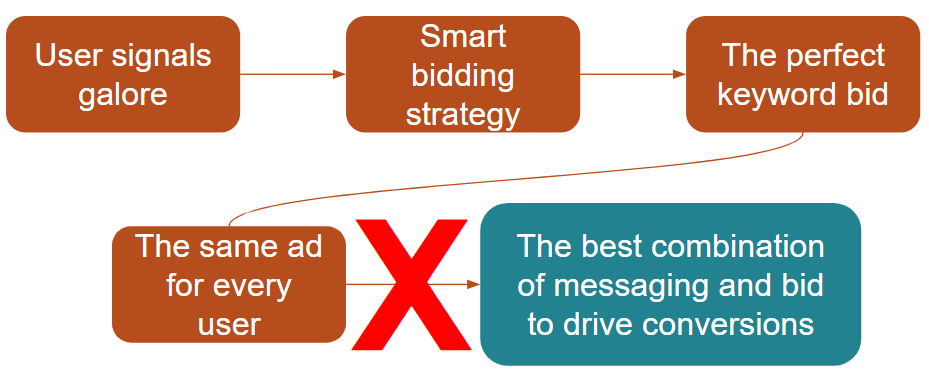
Smart bidding with RSAs fuels Google’s AI and can supercharge your paid search performance.
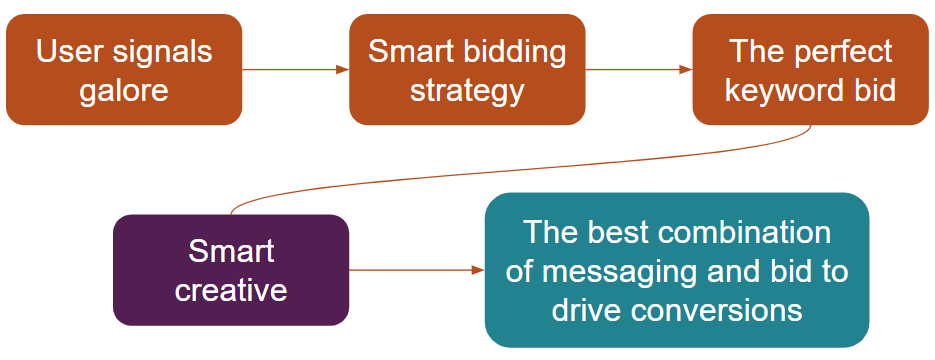
Analyze existing ad copy to leverage top-performing assets
The first step in crafting strong RSAs, as mentioned in the best practices section of this post, begins with utilizing the top performing assets of your existing ad copy.
Download your ad data and pivot it in Excel or utilize a tool like PowerBI to pull out the copy and calls-to-action (CTA) that drives the most value.
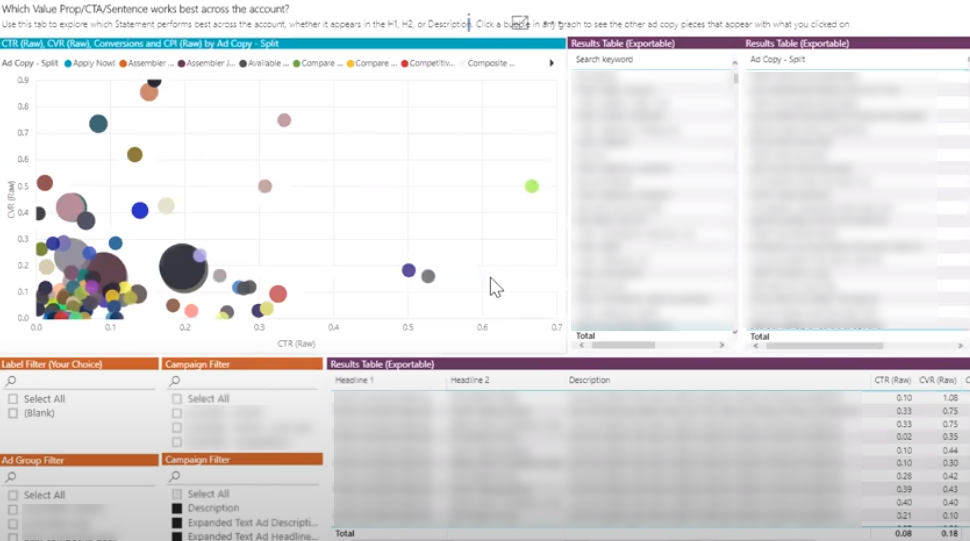
Screenshot of Seer’s ad copy analysis via PowerBI.
Observe the SERP
Next, in order to show your customers ads that resonate with them, you need to understand their questions and pain points.
This does not require a fancy analysis. Search for your brand, top keywords, or your products and observe what Google returns on the results page.
What questions are people asking? Who is showing up organically on page 1? What are their meta descriptions and page titles? Google is rewarding them, take notice!
Leverage People Also Ask, Answer Boxes, and other organic listings and tools like Answer The Public, Authority Labs, SEMRush, and Ahrefs to fuel your RSA ad copy.
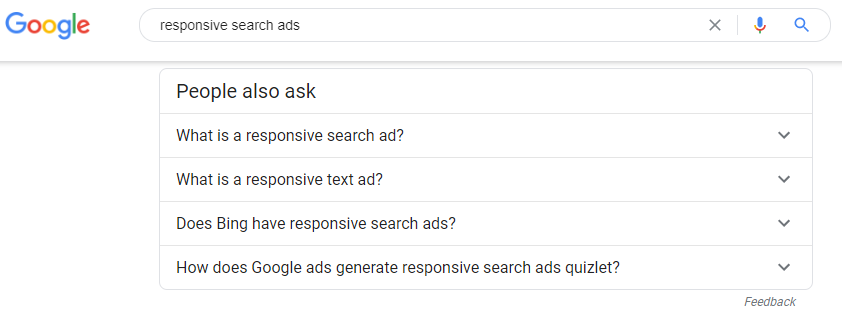
What are your current customers saying?
Finally, don’t only rely on the copy that is currently on your website or in your account to build your RSAs. It is a poor assumption that the way you are currently addressing your customers is the right way to address them. Take advantage of these other opportunities to learn about your customers:
- If you have a sales team, set up time to meet with them and dig in on what customers are saying.
- Read through online reviews of your company (or better yet pull that data into PowerBI and analyze at scale!).
- Comb through forums like Reddit to get honest testimonials and conversations.
- Set up customer interviews to better address their needs and write better ad copy.
For more ideas, watch our webinar on how to uncover customer insights and pain points and how to improve your messaging.
Let us know what you think about this guide and what methods you’ve used to try out responsive search ads in the past. Go forth and prosper.

